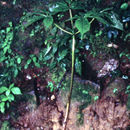Distribution
provided by Plants of Tibet
Nepal
Evolution
provided by Plants of Tibet
The phylogeny of Panax using the ITS sequences of nuclear ribosomal DNA (Wen and Zimmer, 1996; Lee and Wen, 2004). The ITS suggests that (1) the Himalayan Panax pseudoginseng is closely related to P. stipuleanatus from southwestern China; (2) the P. pseudoginseng-P. stipuleanatus clade is basal among the Asiatic species. Wen indeed found Panax pseudoginseng sympatric with P. bipinnatifidus in the type locality of the former and in other locations in Nepal as well. However, Yoo et al. (2001) found that the two species collected in the same location had very distinct chloroplast DNA and nuclear ribosomal ITS profiles. Based on the morphological variation and the phylogenetic relationships, Wen (2001) proposed a classification scheme for Panax, in which Panax pseudoginseng belong to Subgenus Panax, Section Pseudoginseng.
General Description
provided by Plants of Tibet
Tubers single or fascicled, fusiform. Rhizomes short. Base of aerial stem with persistent glabrous and membranaceous scales. Stem glabrous, 25-50 cm long. Leaves 3-4, with persistent stipules; leaflets lanceolate or narrowly elliptic, upper surface with bristly hairs along veins and veinlets, lower surface glabrous. Inflorescence with 1-3 umbels, each 40-65 flowered. Fruit red, 1-2 seeded. Seeds broadly kidney-shaped, 7-7.5 mm long, 6-6.5 mm wide, 5-6 mm thick, surface rough.

